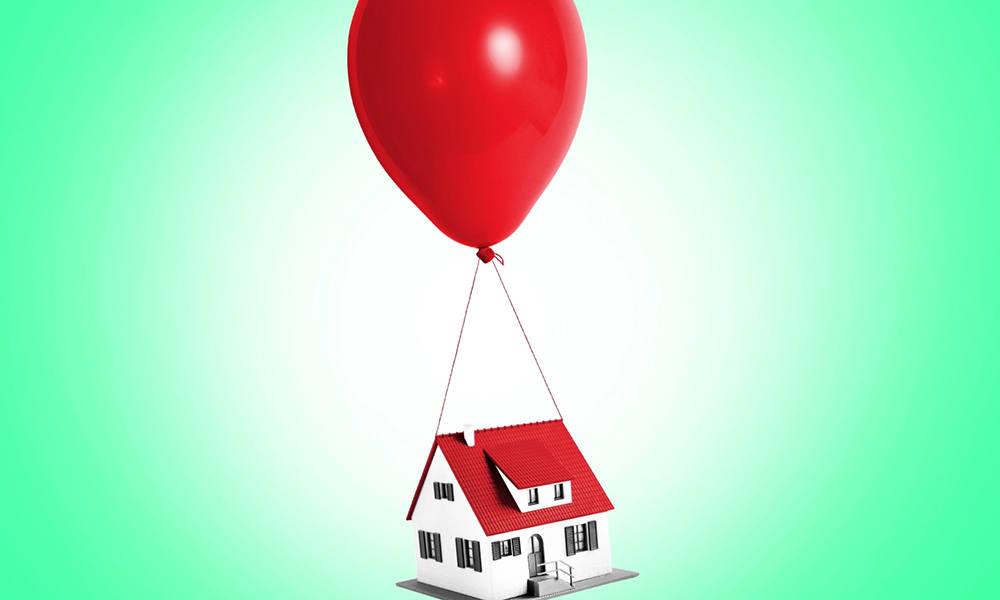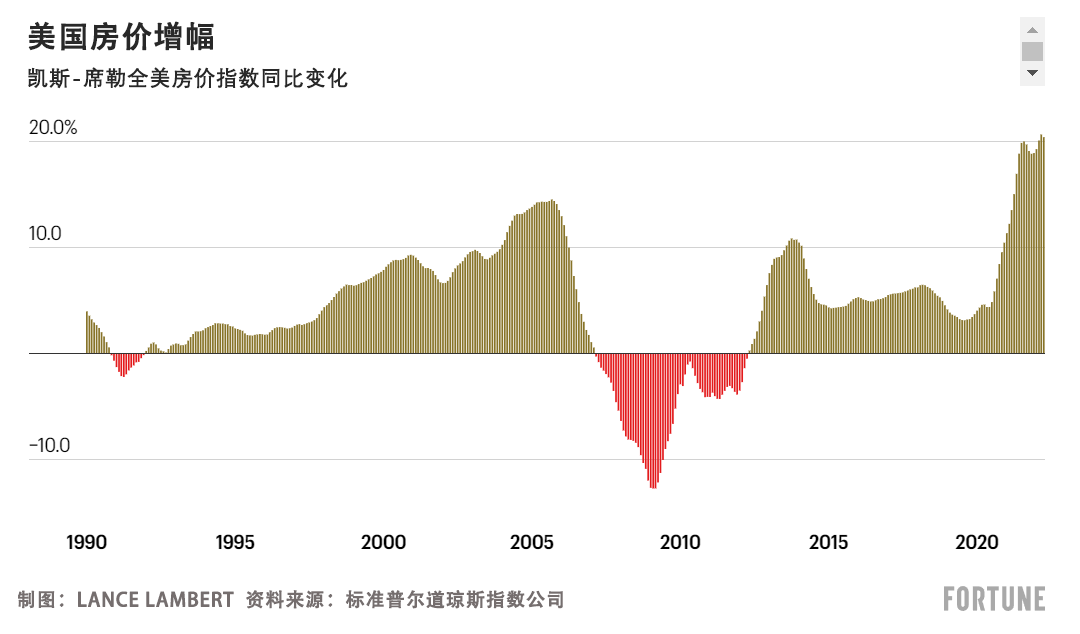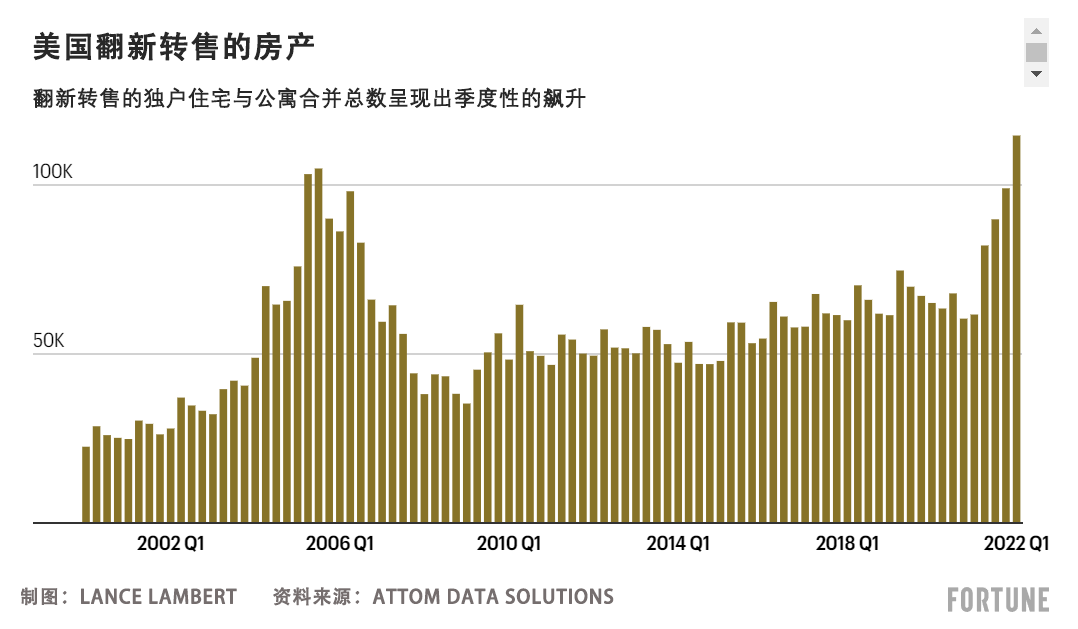
罗伯特·席勒在2000年出版了一本名为《非理性繁荣》(Irrational Exuberance)的书作,并在书中预测了股市泡沫。不久之后,科技泡沫破灭了。2004年,这位耶鲁经济学教授呼吁人们警惕不断攀升的房地产价格,并发表了题为《房产市场是否存在泡沫?》(Is There a Bubble in the Housing Market?)的文章。2007年,席勒预测这一泡沫的破灭是不可避免的。不久之后,2008年美国房产泡沫便破灭了。
虽然疫情期间的房产热已大幅降温,但在过去两年中将美国房产价格推高了42%,并引发了一个疑问:席勒是否认为我们又进入了房产泡沫?
8月7日,席勒接受了雅虎财经(Yahoo Finance)的采访。他对该媒体说,他觉得美国房产市场正在向另一场灾难迈进。
席勒说:“房产价格自2007-2009年经济衰退之后并没有下跌。如今的局面几乎和当时一样糟糕。现有房产的销量出现了下滑。许可申请也有所下滑。大量迹象表明,风雨即将来临,虽然可能不是灾难性的,但未雨绸缪的时候到了。”
席勒表示,房价下探的可能性非常大。
席勒告诉雅虎财经:“芝加哥商品交易所(Chicago Mercantile Exchange)为房价设立了期货市场……目前处于现货溢价阶段;房价预计在2024年或2025年出现略高于10%的降幅。这是个合理的估计。如今,买房存在较高的风险。”

尽管全美房价的下滑鲜有发生,但偶尔也还是会出现。例如20世纪80年代初,还有20世纪90年代初,最显著的还是2008年房产市场崩盘后的那几年。然而,像席勒所说的10%的降幅还是很少见的。房价仅在大萧条和大衰退时期出现过如此高的降幅。如果10%的房价降幅真的成为现实,那么疫情房产热在人们记忆中很有可能成为疫情房产泡沫。
从本质来看,房产泡沫形成的背后有三大因素。
第一个因素是“投机”。在教科书式的房产泡沫中,大量的投资者和投机者将涌入市场,追逐不断飙升的房价。这种现象在过去两年并不少见。不仅房产翻转达人(home flippers,购买旧房产,翻新后再售卖出去——译者注)回归了,而且投资者也目睹了其独户住宅购买比例升至创纪录的水平。房屋建造商也有点忘乎所以。需求是如此之旺盛,以至于建造商决定不用再去看买家的脸色。在业界,这类房产被称之为投机房产,而且在建数量已经达到了创纪录的水平。

第二个因素是“定价过高”。在房产泡沫中,房价会远高于历史上的收入支撑能力。CoreLogic、穆迪分析(Moody's Analytics)以及佛罗里达亚特兰大大学(Florida Atlantic University)研究人员各自开展的独立调查显示,我们已经来到了这个节点。

投机?有了。定价过高?有了。
然而,我们依然没看到第三个刺破泡沫的因素出现。如果房价不暴跌,那就不是房产泡沫。
尽管席勒认为房价可能会出现双位数下滑,但业界很多人并不同意。抵押银行协会(Mortgage Bankers Association)、房利美(Fannie Mae)、房地美(Freddie Mac)、CoreLogic和Zillow的预测模型显示,在接下来的一年中,房价有望进一步上升。与此同时,John Burns Real Estate Consulting、凯投宏观(Capital Economics)、Zelman & Associates和Zonda则预测房价会出现温和的下探。
为什么一些业内人士认为房价下滑的概率不大?首先,美国已经禁止了在10年前导致市场崩盘的次级贷。何况,房屋所有者这一次背负的债务更少。在2007年,抵押贷款服务支出占到了美国可支配收入的7.2%。如今仅有3.8%。
一些公司拒绝看跌房价的另一个原因在于:房产存在历史供应不足的情况。
Zillow公司的发言人威尔·莱姆基对《财富》说:“我们的经济学家如今多少看到了这一点:市场正在放缓,但房价并不会在短时间内下滑。价格增幅会放缓/持平(与年初极快的增速相比),但供应短缺是价格能够继续坚挺的根本支撑。”
在房价唱衰者的眼中,像Zillow这类公司都低估了超额供应的可能性。在他们看来,所有这些在建的投机房产可能会在2023年在亚特兰大、奥斯丁和达拉斯等类似市场出现供应过量的现象。而这种现象的发生会给房价带来下行压力。
Zonda首席经济学家对《财富》杂志说:“业界认为房产市场存在结构性供应不足的情况,然而,受周期性因素影响,这里存在一个风险:市场上的房屋供应量会在短期内超过买家的数量。我想大家都充分意识到,在部分市场,房产库存的增加可能并没有赶上好时候,因为这个时期的需求出现了明显的收缩。我们并不认为房价只会上行……我们的预测显示,房价将出现温和下滑。”(财富中文网)
译者:冯丰
审校:夏林
罗伯特·席勒在2000年出版了一本名为《非理性繁荣》(Irrational Exuberance)的书作,并在书中预测了股市泡沫。不久之后,科技泡沫破灭了。2004年,这位耶鲁经济学教授呼吁人们警惕不断攀升的房地产价格,并发表了题为《房产市场是否存在泡沫?》(Is There a Bubble in the Housing Market?)的文章。2007年,席勒预测这一泡沫的破灭是不可避免的。不久之后,2008年美国房产泡沫便破灭了。
虽然疫情期间的房产热已大幅降温,但在过去两年中将美国房产价格推高了42%,并引发了一个疑问:席勒是否认为我们又进入了房产泡沫?
8月7日,席勒接受了雅虎财经(Yahoo Finance)的采访。他对该媒体说,他觉得美国房产市场正在向另一场灾难迈进。
席勒说:“房产价格自2007-2009年经济衰退之后并没有下跌。如今的局面几乎和当时一样糟糕。现有房产的销量出现了下滑。许可申请也有所下滑。大量迹象表明,风雨即将来临,虽然可能不是灾难性的,但未雨绸缪的时候到了。”
席勒表示,房价下探的可能性非常大。
席勒告诉雅虎财经:“芝加哥商品交易所(Chicago Mercantile Exchange)为房价设立了期货市场……目前处于现货溢价阶段;房价预计在2024年或2025年出现略高于10%的降幅。这是个合理的估计。如今,买房存在较高的风险。”
尽管全美房价的下滑鲜有发生,但偶尔也还是会出现。例如20世纪80年代初,还有20世纪90年代初,最显著的还是2008年房产市场崩盘后的那几年。然而,像席勒所说的10%的降幅还是很少见的。房价仅在大萧条和大衰退时期出现过如此高的降幅。如果10%的房价降幅真的成为现实,那么疫情房产热在人们记忆中很有可能成为疫情房产泡沫。
从本质来看,房产泡沫形成的背后有三大因素。
第一个因素是“投机”。在教科书式的房产泡沫中,大量的投资者和投机者将涌入市场,追逐不断飙升的房价。这种现象在过去两年并不少见。不仅房产翻转达人(home flippers,购买旧房产,翻新后再售卖出去——译者注)回归了,而且投资者也目睹了其独户住宅购买比例升至创纪录的水平。房屋建造商也有点忘乎所以。需求是如此之旺盛,以至于建造商决定不用再去看买家的脸色。在业界,这类房产被称之为投机房产,而且在建数量已经达到了创纪录的水平。
第二个因素是“定价过高”。在房产泡沫中,房价会远高于历史上的收入支撑能力。CoreLogic、穆迪分析(Moody's Analytics)以及佛罗里达亚特兰大大学(Florida Atlantic University)研究人员各自开展的独立调查显示,我们已经来到了这个节点。
投机?有了。定价过高?有了。
然而,我们依然没看到第三个刺破泡沫的因素出现。如果房价不暴跌,那就不是房产泡沫。
尽管席勒认为房价可能会出现双位数下滑,但业界很多人并不同意。抵押银行协会(Mortgage Bankers Association)、房利美(Fannie Mae)、房地美(Freddie Mac)、CoreLogic和Zillow的预测模型显示,在接下来的一年中,房价有望进一步上升。与此同时,John Burns Real Estate Consulting、凯投宏观(Capital Economics)、Zelman & Associates和Zonda则预测房价会出现温和的下探。
为什么一些业内人士认为房价下滑的概率不大?首先,美国已经禁止了在10年前导致市场崩盘的次级贷。何况,房屋所有者这一次背负的债务更少。在2007年,抵押贷款服务支出占到了美国可支配收入的7.2%。如今仅有3.8%。
一些公司拒绝看跌房价的另一个原因在于:房产存在历史供应不足的情况。
Zillow公司的发言人威尔·莱姆基对《财富》说:“我们的经济学家如今多少看到了这一点:市场正在放缓,但房价并不会在短时间内下滑。价格增幅会放缓/持平(与年初极快的增速相比),但供应短缺是价格能够继续坚挺的根本支撑。”
在房价唱衰者的眼中,像Zillow这类公司都低估了超额供应的可能性。在他们看来,所有这些在建的投机房产可能会在2023年在亚特兰大、奥斯丁和达拉斯等类似市场出现供应过量的现象。而这种现象的发生会给房价带来下行压力。
Zonda首席经济学家对《财富》杂志说:“业界认为房产市场存在结构性供应不足的情况,然而,受周期性因素影响,这里存在一个风险:市场上的房屋供应量会在短期内超过买家的数量。我想大家都充分意识到,在部分市场,房产库存的增加可能并没有赶上好时候,因为这个时期的需求出现了明显的收缩。我们并不认为房价只会上行……我们的预测显示,房价将出现温和下滑。”(财富中文网)
译者:冯丰
审校:夏林
Robert Shiller released a book in 2000 titled Irrational Exuberance, which proclaimed the stock market was a bubble. Soon afterward, the tech bubble burst. Then in 2004, the Yale economics professor called attention to spiking real estate prices with a paper titled Is There a Bubble in the Housing Market? By 2007, Shiller predicted its bust was inevitable. Soon afterward, of course, the 2008 housing bubble burst.
As the pandemic housing boom—which has pushed up U.S. home prices by 42% over the past two years—fizzles out, it raises the question: Does Shiller think we’re in another housing bubble?
On Sunday, Shiller spoke with Yahoo Finance. He told the outlet that he once again thinks the U.S. housing market is headed for trouble.
“Home prices haven’t fallen since the 2007–09 recession. Right now things look almost as bad,” Shiller said. “Existing home sales are down. Permits are down. A lot of signs that we’ll see something. It may not be catastrophic, but it’s time to consider that.”
A drop in home prices, Shiller says, looks very possible.
“The Chicago Mercantile Exchange has a futures market for home prices…That’s in backwardation now; [home] prices are expected to fall by something a little over 10% by 2024 or 2025. That’s a good estimate,” Shiller told Yahoo Finance. “The risks are heightened right now for buying a house.”
While national home price declines are rare, they do occur on occasion. It happened in the early 1980s, then again in the early 1990s, and most notably in the years following the 2008 housing bust. However, 10% declines, like Shiller suggests, are very rare. Only the Great Depression and the Great Recession have seen price cuts of that magnitude. If that 10% home price decline actually manifests, the pandemic housing boom will likely be remembered as the pandemic housing bubble.
At its core, a housing bubble requires three elements.
The first element is "speculation." A textbook housing bubble would see a swarm of investors and speculators rush in to chase soaring home price appreciation. That's something we saw a lot over the past two years. Not only did home flippers return, but investors also saw their share of single-family home purchases rise to a record level. Homebuilders got carried away too. Demand was so fierce that builders decided they didn't need to wait on buyers. In the industry, those homes are known as spec homes—meaning speculative homes—and there's currently a record number of them under construction.
The second element is "overvaluation." A housing bubble sees home prices go far beyond what incomes historically would support. We're already at that point. That's according to separate studies conducted by researchers at CoreLogic, Moody's Analytics, and Florida Atlantic University.
Speculation? Check. Overvaluation? Check.
But we still don't have the third element: a bursting bubble. If home prices don't plummet, it isn't a housing bubble.
While Shiller thinks a double-digit decline in home prices is possible, many in the industry don't agree. Over the coming year, home prices are expected to rise. That's according to forecast models produced by the Mortgage Bankers Association, Fannie Mae, Freddie Mac, CoreLogic, and Zillow. Meanwhile, modest home price declines are currently being forecast by John Burns Real Estate Consulting, Capital Economics, Zelman & Associates, and Zonda.
Why do some industry insiders think home price declines are unlikely? For starters, the country outlawed the subprime mortgages that sank the market a decade ago. Not to mention, homeowners are less debt-burdened this time around. Back in 2007, mortgage debt service payments accounted for 7.2% of U.S. disposable income. Now it's just 3.8%.
There's another reason some firms refuse to get bearish on home prices: a historic undersupply of homes.
"Our economists have been chiming in on this for a bit now: The market is slowing down, but homes aren’t getting cheaper anytime soon. Price growth will slow/flatten (when compared to the breakneck start of the year), but the lack of supply is a fundamental pressure that will keep values aloft," Will Lemke, Zillow's spokesperson, tells Fortune.
In the eyes of housing bears, firms like Zillow are underestimating the possibility of oversupply. In their view, there's a chance all those spec homes under construction could see markets like Atlanta, Austin, and Dallas get oversupplied in 2023. If that happens, it would put downward pressure on home prices.
"Housing is believed to be structurally undersupplied, but we run the risk of finding more homes on the market than buyers in the near term due to cyclical factors. I think there’s full awareness that in some markets, an increase in inventory may hit at a bad time—a time where demand has notably pulled back," Ali Wolf, chief economist at Zonda, tells Fortune. "We are not under the belief that home prices only go up…Our forecast calls for a modest drop in housing prices."






